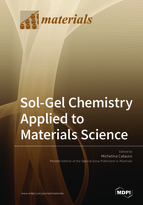Sol-Gel Chemistry Applied to Materials Science
A special issue of Materials (ISSN 1996-1944).
Deadline for manuscript submissions: closed (15 January 2018) | Viewed by 66843
Special Issue Editor
Interests: sol-gel technology; biomaterials; bioglass; organic–inorganic hybrid materials; drug delivery; thin films
Special Issues, Collections and Topics in MDPI journals
Special Issue Information
Dear Colleagues,
The sol-gel process has been known since the late 1800s; however, in the last three decades, the process has been extensively developed, enabling the preparation of new and advanced materials that are not easy to obtain using other methods.
The sol-gel technique is a versatile synthesis method used to produce glasses and ceramics at low temperatures. Sol-gel chemistry is based on the hydrolysis of metal alkoxide precursors into a water/alcohol solution, and the polycondensation of the formed oligomers, which leads to the formation of a 3D inorganic network. Therefore, the process involves the transition of a system from a mostly colloidal liquid (‘sol’) into a solid ‘gel’. By drying the obtained wet gel, it is possible to prepare xerogels (by exposure to low temperatures) or aerogels (by solvent extraction under supercritical conditions) or dense ceramic and glass by means of further heat treatment at higher temperatures.
The increasing attention given to this method is due to its versatility, which is derived from the various special shapes obtained directly from the gel state (e.g., monoliths, film, fibers, nanoparticles and monosized powders). Many parameters of the sol-gel process, indeed, can be modulated in order to control the chemical composition, microstructure, and, thus, the properties of the obtained materials. Moreover, the low processing temperatures allow to entrap thermolabile molecules (polymers, drugs, biomulecules, etc.) in the inorganic glassy matrix, making the sol-gel process an ideal technique to prepare organic–inorganic hybrid materials. The leading idea in their development is to take the advantageous properties of each component, which forms the hybrid, by trying to decrease or eliminate its drawbacks, through a synergic effect, which results in the generation of a new material with new properties.
The multidisciplinary approach of sol-gel technology, therefore, has allowed the development of materials for a wide range of applications: To produce optical fibers, optical or anticorrosive coatings, catalysts, wave guides, chemical sensors, biosensor, bioglass, and drug delivery systems.
Now potential applications of sol-gel technology are now continuously emerging into new areas of discovery.
It is my pleasure to invite you to submit a manuscript for this Special Issue. Full papers, communications, and reviews are all welcome.
Prof. Michelina Catauro
Guest Editor
Manuscript Submission Information
Manuscripts should be submitted online at www.mdpi.com by registering and logging in to this website. Once you are registered, click here to go to the submission form. Manuscripts can be submitted until the deadline. All submissions that pass pre-check are peer-reviewed. Accepted papers will be published continuously in the journal (as soon as accepted) and will be listed together on the special issue website. Research articles, review articles as well as short communications are invited. For planned papers, a title and short abstract (about 100 words) can be sent to the Editorial Office for announcement on this website.
Submitted manuscripts should not have been published previously, nor be under consideration for publication elsewhere (except conference proceedings papers). All manuscripts are thoroughly refereed through a single-blind peer-review process. A guide for authors and other relevant information for submission of manuscripts is available on the Instructions for Authors page. Materials is an international peer-reviewed open access semimonthly journal published by MDPI.
Please visit the Instructions for Authors page before submitting a manuscript. The Article Processing Charge (APC) for publication in this open access journal is 2600 CHF (Swiss Francs). Submitted papers should be well formatted and use good English. Authors may use MDPI's English editing service prior to publication or during author revisions.
Keywords
Biomaterials
Drug Delivery
Nanoparticles
Thin Films and Coatings
Organic–Inorganic Hybrid Materials
Catalysts
Sensors and biosensors







